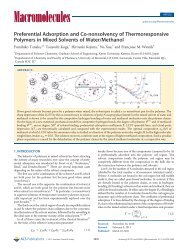pdf file
pdf file
pdf file
Create successful ePaper yourself
Turn your PDF publications into a flip-book with our unique Google optimized e-Paper software.
STEIN EXTENSIONS OF RIEMANN SYMMETRIC SPACES AND SOME GENERALIZATION 7of ρ. Since ρ a is left H ′ -invariant and right aHa −1 -invariant, we have only to showthat the function ρ ′ a(X) = ρ a (exp X) for X ∈ V is real analytic at 0 by (2.2) and(2.5) where U ⊂ t and V = Ad(H ′ ∩ aHa −1 ) 0 U ⊂ q ′ ∩ Ad(a)q are as in the proofof Proposition 1. Since ρ a (gxg −1 ) = ρ a (x) for g ∈ H ′ ∩ aHa −1 and x ∈ exp V , ρ ′ ais Ad(H ′ ∩ aHa −1 )-invariant. Note that (H ′ ∩ aHa −1 ) 0 = (Z K∩H (Y )) 0 by Lemma 2and thatρ ′ a(Z) = ρ((exp Z)a) = ρ 0 (Z + Y ) for Z ∈ Uis invariant under the action of w ∈ W such that w(Y ) = Y . Since we can easilyextend the well-known Chevalley’s restriction theorem to real analytic functions at0, the function ρ ′ a on V = Ad(H ′ ∩ aHa −1 ) 0 U is real analytic at 0. q.e.d.Remark 3. (i) The function ρ on D has no critical points outside H ′ H = H ′ eHby the assumption on ρ 0 .(ii) If ρ 0 is a W -invariant smooth function on t + . Then we can show that ρ is asmooth function on D by using [S].The tangent space T a (G) of G at a is identified with g = T e (G) by the righta-action. In other words, we identify T a (G) with the left infinitesimal action of g ata. Now we have the following key lemma.Lemma 3. Let a = exp Y with Y ∈ t + − {0}. Then the hyperplane in T a (G)defined by dρ = 0 is orthogonal, with respect to the Killing form on g, to a nonzerovector Z in k.Proof. Taking the right a-translate ρ a of ρ as in the proof of Proposition 3, wehave only to consider the hyperplane in the tangent space T e (G) ∼ = g defined bydρ a = 0.Since ρ a is left H ′ -invariant and right aHa −1 -invariant, the differential dρ a vanisheson h ′ + Ad(a)h. Hence the normal vector Z is contained in the orthogonalcomplement q ′ ∩ Ad(a)q (⊂ k by Lemma 2) of h ′ + Ad(a)h.q.e.d.4. Proof of TheoremProof of Theorem. Basic formulation is the same as Proposition 2.0.2 in [FH].Suppose that D ⊄ P H. We will deduce a contradiction.Let P xH be a P -H double coset with the least dimension among the P -H doublecosets intersecting D. So the intersection P xH ∩ D is relatively closed in D. SinceH ′ P = (K ∩ H)P by [M2], we have H ′ = (K ∩ H)(P ∩ H ′ ) = (P ∩ H ′ )(K ∩ H).Hence P xH intersects (K ∩ H)T + and the image of ρ| P xH∩D is equal to the imageof ρ| P xH∩(K∩H)T +. The set {x ∈ (K ∩ H)T + | ρ(x) ≤ m} is compact for anym ∈ R because we carefully assumed that ρ 0 is +∞ on the boundary of t + . Hencethe function ρ| P xH∩D attains its minimum on some point ka with k ∈ K ∩ H anda ∈ T + . Replacing P by the k-conjugate k −1 P k, we may assume k = e. Sincea ∈ P xH and P xH ∩ P H = ϕ, we have a ≠ e.By Lemma 3, there is a nonzero element Z in k such that Z is orthogonal top = Lie(P ). But this leads a contradiction because Z ∈ k is also orthogonal to θpand therefore Z is orthogonal to p + θp = g which cannot happen since the Killingform is nondegenerate on g.q.e.d.












